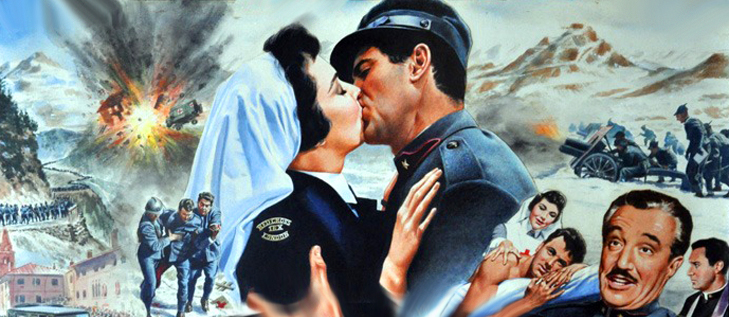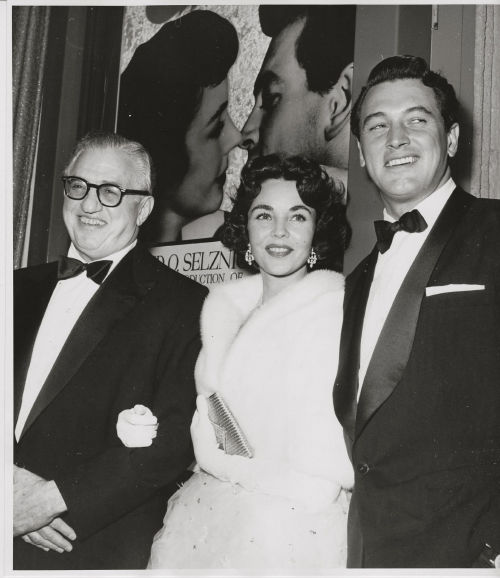Variations on the same theme: A Farewell to Arms (1932 and 1957)
Você com certeza já ouviu falar de Ernest
Hemingway, o escritor americano que adorava duas coisas: a vida boêmia e gatos.
Nenhum destes interesses do autor tem espaço naquela que é sua mais famosa
obra: o romance “Adeus às Armas”.
You probably have heard
about Ernest Hemingway, the American writer who loved two things: bohemia and
cats. None of these appears in the author's most famous book, the novel “A
Farewell to Arms”.
Hemingway foi motorista de ambulância na Itália
durante a Primeira Guerra Mundial, e em 1929 publicou um livro baseado nesta
experiência. Em “Adeus às Armas”, o motorista de ambulância americano Frederic
Henry e a enfermeira inglesa Catherine Barkley se apaixonam durante a guerra. O
amor poderá esperar até que haja paz? É só isso. E é só o começo de tudo.
Hemingway was an
ambulance driver in Italy during World War I, and in 1929 published a book
based on these times. In “A Farewell to Arms”, the American ambulance driver
Frederic Henry and the English nurse Catherine Barkley fall in love amidst the
war. Could love wait until peace arrives? That's basically it. And that's just
the beginning of everything.
No ano seguinte à publicação do livro, a história
foi adaptada para o teatro e logo foi feita uma versão para o cinema. Fredric
March, contratado para ser o protagonista, recusou o papel ao saber que Frank
Borzage o dirigiria. Foi a oportunidade perfeita para um homem alto e charmoso
que crescia cada vez mais em Hollywood: Gary Cooper.
The years after the book
was published, the story was adapted into a play and soon an adaptation to the
screen followed. Fredric March, hired to be the leading man, refused it when he
heard that Frank Borzage was assigned as the director. It was a perfect
opportunity for a tall and charming man who was getting more and more space in
Hollywood: Gary Cooper.
Ao seu lado estava Helen Hayes, admirada no
teatro – onde começou aos cinco anos interpretando meninos – e que havia
ganhado o Oscar de Melhor Atriz no ano anterior. Em apenas uma hora e meia – a
versão de 1957 tem duas horas e meia – as mais de trezentas páginas do romance
de Hemingway são contadas com boas omissões. O foco fica no casal e
não na guerra.
Next to him there was
Helen Hayes, an admired lady of the theater – where she started at five playing
male roles – and who had just won the Best Actress Oscar the year before. In
just an hour and a half – the 1957 version is two and a half hours long – the
more than 300 pages from Hemingway's novel are told with a lot of ommissions. The focus is on the couple, not the war.
Like anything Borzage
did, “A Farewell to Arms” is a feast for the eyes. You are in the war, but you
have a beautiful palace where the nurses and commanders stay, with a glorious
fountain in the garden. This garden is the scenario for the most beautiful and
romantic scenes of the movie.
Helen Hayes desenvolveu um crush em Gary Cooper,
enquanto Cooper e Hemingway se tornaram grandes amigos. O que não deixou
Hemingway feliz foi a maneira como Hollywood tratou seu precioso material,
mudando o personagem Rinaldi (interpretado por Adolphe Menjou), e até filmando
dois finais para que os donos dos cinemas pudessem decidir se queriam um final
feliz ou triste para a sessão. No final, as críticas foram diversas, mas em sua
maioria positivas.
Helen Hayes developed a
crush on Gary Cooper, while Cooper and Hemingway became lifelong friends. What
didn't make Hemingway happy was how Hollywood tackled his precious material,
changing character Rinaldi (played by Adolphe Menjou), and even filming two
endings so theater owners could decide if they wanted a happy or a sad ending
for the session. In the end, the reviews were mixed, but mostly positive.
Desde o começou tem-se a impressão de que David
O. Selznick quis repetir com sua adaptação de “Adeus às Armas” o sucesso de “E
o Vento Levou...”. O próprio título é apresentado da mesma forma, com as letras
imensas rolando da direita para a esquerda da tela. Assim como sua obra de
1939, este também conta com cenários de tirar o fôlego, o tema da guerra, os
muitos feridos e o uso expressivo da cor.
Since the beginning we
get the impression that David O. Selznick was trying, with his adaptation of “A
Farewell to Arms”, to repeat the success of “Gone with the Wind”. The title
itself is presented the same way, with huge letter rolling from right to left
on the screen. Just like his 1939 film, this one also has breathtaking
scenarios, the war theme and an expressive use of color.
Protagonizado por Rock Hudson, interpretando
Frederic como um tenente, e Jennifer Jones, conta ainda com os talentos
secundários de Vittorio de Sica, Alberto Sordi e Mercedes McCambridge. Um
usuário do IMDb não considerou boa a escalação de Jennifer, então esposa de
Selznick, para o papel principal (e não tenho dúvida de que, se o produtor
tivesse conhecido Jennifer nos anos 30, apesar da pouca idade, ele faria um
lobby para ela ser incluída no elenco do épico sobre a Guerra Civil Americana).
O usuário disse que Jennifer era velha demais para o papel.
The film is lead by Rock
Hudson, playing Frederic as a lieutenant, and Jennifer Jones, and also have, as
supporting players, Vittoria de Sica, Alberto Sordi and Mercedes McCambridge.
An IMDb user didn't like the casting of Jennifer Jones, then Selznick's wife,
as the lead (and I have no doubt that, if the producer had met Jennifer in the
1930s, even though she was too young, he would have lobbied for a role for her
in the Civil War epic). The user said Jennifer was too old for the part.
Embora eu goste da atriz (sensacional em “A
Canção de Bernadette”, de 1943), fica claro que o filme foca mais no personagem
de Hudson. Entretanto, se fosse necessário substituir a protagonista, surgem
duas possibilidades em minha mente: Deborah Kerr, o que não seria ruim já que
ela continuaria a ser mais velha que Rock, ou Elizabeth Taylor, que à primeira
vista parece perfeita para o papel.
Even though I like
Jennifer (who is sensational in “The song of Bernadette”, from 1943), it's clear that the film is
focused on Rock's character. But if it was necessary to replace the leading
lady, I'd have two suggestions: Deborah Kerr, who was also older than Rock, and
Elizabeth Taylor, who seems just perfect for the role.
Selznick só conseguiu o direito para adaptar a
obra de Hemingway através de uma troca: a Warner Brothers, que possuía esse
direito, queria fazer uma nova versão de “Nasce uma Estrela”, que estava sob a
tutela de Selznick, produtor da versão de 1937. A troca foi simples e as
ambições de Selznick começaram a se acumular.
Selznick only got the
rights to adapt Hemingway's book through an exchange: Warner Brothers, who had
this right, wanted to make a new version of “A Star is Born”, and Selznick, who
produced the 1937 version, had the rights over the story. The exchange was
simple and Selznick's ambitions started to pile up.
Buscando cenários autênticos, Selznick demitiu o primeiro diretor, John Huston, e mandou Charles Vidor filmar nos Alpes italianos. Ele também não economizou na duração do filme, e foi mais fiel ao livro de Hemingway, embora novamente focasse mais no casal e menos na guerra. No final, foi um filme grandioso, mas uma decepção para a crítica e a bilheteria.
Looking for authentic
scenarios, Selznick fired his first director, John Huston, and sent Charles
Vidor to shoot in the Italian Alps. He also didn't save on screen time, and was
more faithful to Hemingway's book, although again focusing more on the couple
than on the war. In the end, it was a grandiose film, but a box office and
critical disappointment.
Estas foram as duas únicas adaptações de “Adeus às Armas” para o cinema. Embora nenhuma das duas seja perfeita por causa das liberdades tomadas, ambas têm qualidades e são bons filmes, cada um em sua fatia da história de Hollywood.
These were the only two
adaptations of “A Farewell to Arms” into feature films. Even though none of the
versions is perfect due to the liberties taken, both have qualities and are
worthy pieces of movie history.
O veredicto: se você
tiver tempo sobrando, veja as duas versões. Mas
leia antes o livro!
The verdict: if you have
enough time, watch both versions. But read the book first!
This is my contribution
to the Medicine in the Movies Blogathon, hosted by Charlene at Charlene’s
(Mostly) Classic Movie Reviews.











6 comments:
Muito obrigado por me lembrar que tenho de reler ADEUS ÀS ARMAS !
Quando o li ( Edições Ulisseia ) ainda era jovem...
Abraço grato.
This is a really insightful and knowledgeable post comparing the two film versions of a classic story. Thanks for sharing and contributing to the blogathon!
Always enjoy reading your lovely posts. I'll keep an eye out for these two versions.
Have a lovely weekend,
Cat
Extremely informative and enjoyable to read 😊 I tried to watch both version but I think the idea of WWI turned me off. After reading, this I need to try again😊
I've only seen the Gary Cooper version, and it truly is beautifully filmed. Like you said, that scene in the garden is gorgeous!
Thanks for reminding me about the Rock Hudson/Jennifer Jones version. I'll try to track it down...although I know, while watching it, I'll wish they had hired Elizabeth Taylor, as per your suggestion! :)
What a lovely post! This looks like a beautiful film. I definitely now want to see it. I know David O. Selznick wanted to repeat the success of "Gone with the Wind" with virtually every film he has made ever since, until he realised it is quite impossible to do so.
Post a Comment